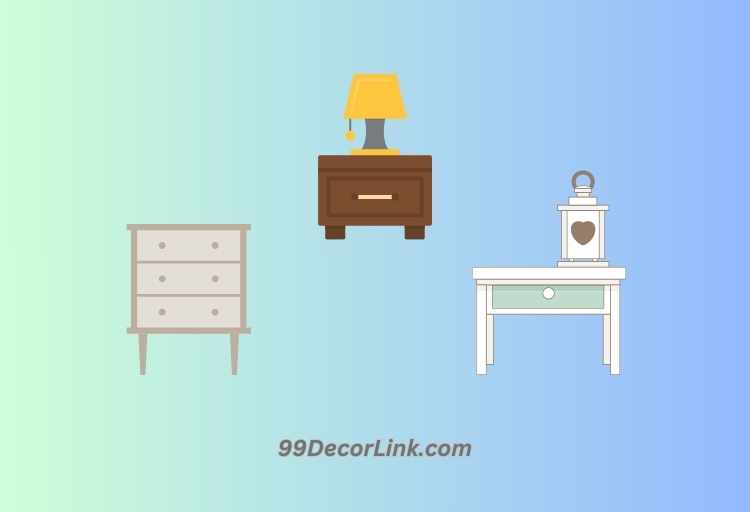How Many Nightstands Do I Need
When determining how many nightstands you need, there are several factors to consider. First, take into account the size of your bed. A larger bed might require two nightstands for a balanced look and convenience on both sides of the bed.
Next, evaluate your storage needs. If you have a lot of items that need to be within arm’s reach while in bed, having two nightstands with drawers or shelves could be beneficial.
Consider symmetry and balance as well. Having just one nightstand can create an asymmetrical look if your bed is centered against a wall or has other furniture nearby.
Lastly, assess the layout and space of your bedroom. If there is limited space or awkward angles, one nightstand might be more practical.
Ultimately, personal preference and style play a significant role in this decision too. Some people prefer the simplicity of one nightstand while others enjoy the added convenience and aesthetic appeal of two.

Contents
Consider the Size of Your Bed
If you’re snoozing in a king-size bed, you’ll want to have two nightstands for maximum symmetry and convenience.
When it comes to bedroom decor, having matching nightstands on either side of your bed can add a touch of elegance and balance to the room. Not only do they enhance the aesthetics, but they also serve a practical purpose.
With two nightstands, you have double the storage space for all your nighttime essentials like books, glasses, or charging stations for your devices. It’s all about functionality and practicality.
Imagine waking up in the middle of the night and not having to reach over to the other side of the bed just to grab something you need. Having two nightstands ensures that everything is within arm’s reach, providing an effortless and convenient experience throughout your slumber.
Evaluate Your Storage Needs
Consider evaluating the amount of storage space that suits your needs when deciding how to furnish your bedroom. When it comes to nightstands, it’s important to take into account your storage requirements.
If you have a lot of items that need to be within reach while you sleep, such as books, glasses, or electronics, you may want to consider having two nightstands—one on each side of the bed. This will provide ample surface area for all your essentials.
However, if you prefer a more minimalistic look and don’t require much storage space, one nightstand might suffice. Alternatively, explore alternative storage solutions like wall-mounted shelves or floating bedside tables. These options can save floor space while still providing a place to store small items.
Additionally, consider multi-functional furniture options like nightstands with built-in drawers or shelves underneath for added storage convenience. By evaluating your storage needs and exploring various options, you can choose the right number of nightstands for your bedroom.
Think about Symmetry and Balance
When furnishing your bedroom, it’s important to think about achieving a sense of symmetry and balance in the placement of your nightstands. By considering furniture arrangement and color palette, you can create a harmonious and visually appealing space.
Here are three reasons why thinking about symmetry and balance is crucial:
- It creates a calming atmosphere: When your nightstands are evenly placed on both sides of the bed, it brings a sense of order and tranquility to the room.
- It enhances functionality: Symmetrical nightstands provide equal storage space for both partners, making it easier to keep essential items within reach.
- It adds aesthetic appeal: Matching nightstands with similar shapes, sizes, or colors create a cohesive look that elevates the overall design of the bedroom.
By incorporating symmetry and balance into your choice of nightstands, you can transform your bedroom into an inviting sanctuary that reflects your personal style.
Assess the Layout and Space of Your Bedroom
Take a moment to evaluate how your bedroom is laid out and the available space you have to work with. When assessing the layout and space of your bedroom, consider furniture placement and how it can affect the overall look and functionality of the room.
One important aspect to consider is nightstand placement. Depending on the size of your bed and the space around it, you may need one or two nightstands. If you have a large bed or ample space on both sides, having two nightstands can create symmetry and balance in the room.
However, if your bed is smaller or there’s limited space, utilizing vertical space by installing floating shelves or wall-mounted bedside tables can be a great alternative. These options provide storage without taking up valuable floor area, making them perfect for smaller bedrooms.
Personal Preference and Style
To truly make your bedroom your own, it’s all about personal preference and adding your unique style to the space. One way to do this is by incorporating nightstands that reflect your taste and personality.
When choosing nightstands, consider different materials such as wood, metal, glass, or even repurposed items for a more eclectic look. These materials can add texture and visual interest to your bedroom.
Additionally, if you have a small bedroom with limited space, there are creative ways to incorporate nightstands without overwhelming the room. You can opt for wall-mounted shelves or floating nightstands that take up less floor space. Another option is using narrow and compact styles that fit snugly next to your bed.
Ultimately, it’s about finding the right balance between functionality and aesthetics when deciding how many nightstands you need in your bedroom.
Conclusion
So, how many nightstands do you need? Ultimately, the answer depends on your specific preferences and needs. Consider the size of your bed and evaluate your storage requirements. Think about symmetry and balance in your bedroom design.
Assess the layout and space available in your bedroom to determine if one or two nightstands would work best. Finally, don’t forget to consider your personal style and preferences when making this decision. Ultimately, choose what works best for you and creates a comfortable and functional space.

